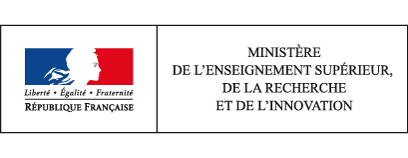28 gross domestic expenditure on research and development
This page has been updated. Read 27. gross domestic expenditure on research and development in Higher education & research in France, facts and figures 10th edition - June 2017
In 2013, half of intramural business expenditure on R&D (BERD) was focused on six industrial branches (‘Manufacture of motor vehicles’, ‘Manufacture of air and spacecraft and related machinery’, ‘Manufacture of basic pharmaceutical products and pharmaceutical preparations’, ‘Computer-related and information service activities’, ‘Professional, scientific and technical activities’ and ‘Manufacture of chemicals and chemical products’). In the public sector, dedicated research institutions (EPST and EPIC) carried out 54% of all R&D funded by intramural government expenditure (GOVERD).
In 2013, intramural business expenditure on research and development (BERD) totalled €30.7 billion, while government expenditure (GOVERD) was €16.8 billion. The increase in gross domestic expenditure on R&D (GERD) in comparison with 2012 was due both to increased business expenditure (1.4% in real terms) and government expenditure (1.0% in real terms) (table 28.01). In 2014, this growth in GERD is expected to slow down (0.7% in real terms), due to a smaller increase in BERD (+0.9%) and GOVERD (0.5%).
The breakdown of BERD among the main fields of research reveals a marked concentration (table 28.02). Six of the 32 research areas receive half of France’s R&D resources: ‘manufacture of motor vehicles’ (13% of BERD); ‘manufacture of air and spacecraft and related machinery’ (11%); ‘manufacture of basic pharmaceutical products and pharmaceutical preparations’ (10%); ‘specialised scientific and technical activities’ and ‘computer-related and information service activities’, each 7%; and ‘manufacture of chemicals and chemical products’ (6%).
Since 2007, the ‘manufacture of motor vehicles’ field has become more dominant, primarily to the detriment of ‘manufacture of air and spacecraft and related machinery’. In 2013, it recorded the same level of expenditure as in 2007. 'Manufacture of air and spacecraft and related machinery’ has been very dynamic since 2011. By contrast, expenditure on the pharmaceutical industry has fallen since 2008.
Taken as a whole, research fields within the service sector received 21% of BERD (€6.6 billion). In the past 3 years, R&D expenditure within the service sector has shown significant growth, increasing by 7.3% a year on average in real terms, in comparison with a fall of 1.5% a year in real terms in industrial R&D expenditure. For the 'primary, energy, construction' sector, the average annual development of +4.7% is triple that for the industrial manufacturing sector.
In 2013, 64.7% of businesses in France carried out R&D, placing France ahead of the United Kingdom (64.5%) but far behind South Korea (79%), Japan (76%), the United States (71%) and Germany (68%) (chart 28.03). However, it should be noted when making comparisons with other countries that R&D by French businesses does not cover the country’s entire technological and industrial field. A considerable proportion of high-level technological R&D is carried out by dedicated State research institutions and foundations.
Public research is carried out by dedicated research institutions (accounting for 55% of GOVERD in 2013), higher education institutions (40%), the private non-profit sector (4%) and government departments and other State institutions (1%) (chart 28.04). In 2013, State-owned scientific and technological establishments (EPST), of which there are eight, carried out 36% of government-funded R&D. They varied widely in size, from the multidisciplinary National Centre for Scientific Research (CNRS), which conducted 19% of government-funded R&D, to the French National Institute for Agricultural Research (INRA) and the French National Institute of Health and Medical Research (INSERM), both of which accounted for 5% of GOVERD. State-owned industrial and commercial establishments (EPIC), of which there are twelve, were responsible for 23% of government-funded R&D. R&D was also highly concentrated among EPICs, with 14% of GOVERD going to the civil division of the French Alternative Energies and Atomic Energy Commission (CEA) and 3% to the French Government Space Agency (CNES), with the remaining EPICs accounting for 5% of GOVERD. Between 2012 and 2013, GERD fell in real terms among EPICs (-0.2%) and in the National Centre for Scientific Research (CNRS). However, R&D expenditure increased in real terms in the other EPSTs (+1.4%), in higher education (+2.1%) and in the not-for-profit sector (+3.6%).
OECD.
How to cite this paper :
close
Key figures
Whole of France
Whole of France
Whole of France
Whole of France
Whole of France
Whole of France
Whole of France
Whole of France
Whole of France
Whole of France
Whole of France
Whole of France
Whole of France
Whole of France
Whole of France
Whole of France
Whole of France
Whole of France
Whole of France
Whole of France
Whole of France
Whole of France
Whole of France
Whole of France
Whole of France
Whole of France
Whole of France
Whole of France
Whole of France
research branch
Whole of France
research branch
Whole of France
research branch
Whole of France
research branch
Whole of France
research branch
Whole of France
research branch
Whole of France
research branch
Whole of France
research branch
Whole of France
research branch
Whole of France
research branch
Whole of France
research branch
Whole of France
research branch
Whole of France
28.01 Performance of R&D in France by businesses and the public sector
1 Evaluated on the basis of the price change for GDP as revised in 2014 (base year = 2010).
2 Government, higher education and the non-profit sector.
3 Final results.
4 Semi-finalised results.
5 Estimates.
You can embed this table to your website or your blog by copying the HTML code and pasting it into the source code of your website / blog:
close
28.02 Breakdown of BERD by branch 1 using the research in 2013 (in €M)
1 Since 2008, the branches that benefit from R&D have been defined using the second edition of the French classification of activities (NAF Rev. 2).
2 See Annex.
3 Semi-finalised results.
You can embed this table to your website or your blog by copying the HTML code and pasting it into the source code of your website / blog:
close
28.03 Proportion of GERD implemented by businesses and governments in the OECD in 2013 (%)
1 Government, higher education and the private-non-profit sector.
2 Excluding (all or part of) capital expenditure.
3 Excluding (all or most) defence.
You can embed this chart to your website or your blog by copying the HTML code and pasting it into the source code of your website / blog:
close
28.04 Gross domestic expenditure on R&D by institutions carrying out public research in 2013 (€M)
You can embed this chart to your website or your blog by copying the HTML code and pasting it into the source code of your website / blog:
close
Related statistical publications
 Note d'information SIES 15.09 - Research and development expenditure in France in 2013 - Christophe Dixte, Anna Testas - December 2015
Note d'information SIES 15.09 - Research and development expenditure in France in 2013 - Christophe Dixte, Anna Testas - December 2015 
 Note flash SIES 05 - Gross domestic expenditure on R&D amounted to €47.5 billion in 2013 - Christophe Dixte, Anna Testas - September 2015
Note flash SIES 05 - Gross domestic expenditure on R&D amounted to €47.5 billion in 2013 - Christophe Dixte, Anna Testas - September 2015 In 2014, the growth in GERD should slow down (+0.7% in real terms) due to the lower growth in government and business expenditure. GOVERD should increase by 0.5% in real terms, reaching €16.9 billion. The increase in BERD should also slow down (+0.9% in real terms), amounting to €31.2 billion in 2014. However, at 2.26%, the nation's research effort should rise slightly once again.
Translation
 Etat de l'enseignement supérieur et de la rechercheL'état de l'Enseignement supérieur et de la Recherche en France n°9 - Juin 2016
Etat de l'enseignement supérieur et de la rechercheL'état de l'Enseignement supérieur et de la Recherche en France n°9 - Juin 201628 - les dépenses intérieures de recherche et développement - Catherine David






